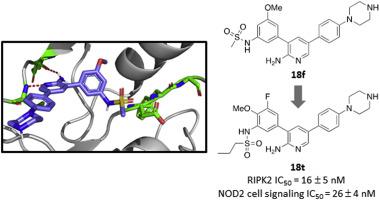European Journal of Medicinal Chemistry ( IF 6.0 ) Pub Date : 2020-05-15 , DOI: 10.1016/j.ejmech.2020.112417 Chalada Suebsuwong 1 , Bing Dai 2 , Daniel M Pinkas 3 , Anantha Lakshmi Duddupudi 4 , Li Li 4 , Joshua C Bufton 3 , Lisa Schlicher 5 , Mads Gyrd-Hansen 5 , Ming Hu 4 , Alex N Bullock 3 , Alexei Degterev 2 , Gregory D Cuny 4

|
Receptor-interacting protein kinase 2 (RIPK2) is a key mediator of nucleotide-binding oligomerization domain (NOD) cell signaling that has been implicated in various chronic inflammatory conditions. A new class of RIPK2 kinase/NOD signaling inhibitors based on a 3,5-diphenyl-2-aminopyridine scaffold was developed. Several co-crystal structures of RIPK2•inhibitor complexes were analyzed to provide insights into inhibitor selectivity versus the structurally related activin receptor-like kinase 2 (ALK2) demonstrating that the inhibitor sits deeper in the hydrophobic binding pocket of RIPK2 perturbing the orientation of the DFG motif. In addition, the structure-activity relationship study revealed that in addition to anchoring to the hinge and DFG via the 2-aminopyridine and 3-phenylsulfonamide, respectively, appropriate occupancy of the region between the gatekeeper and the αC-helix provided by substituents in the 4- and 5-positions of the 3-phenylsulfonamide were necessary to achieve potent NOD cell signaling inhibition. For example, compound 18t (e.g. CSLP37) displayed potent biochemical RIPK2 kinase inhibition (IC50 = 16 ± 5 nM), >20-fold selectivity versus ALK2 and potent NOD cell signaling inhibition (IC50 = 26 ± 4 nM) in the HEKBlue assay. Finally, in vitro ADME and pharmacokinetic characterization of 18t further supports the prospects of the 3,5-diphenyl-2-aminopyridine scaffold for the generation of in vivo pharmacology probes of RIPK2 kinase and NOD cell signaling functions.
中文翻译:

基于3,5-二苯基-2-氨基吡啶骨架的受体相互作用蛋白激酶2(RIPK2)和核苷酸结合寡聚域(NOD)细胞信号抑制剂。
受体相互作用蛋白激酶2(RIPK2)是核苷酸结合寡聚域(NOD)细胞信号传导的关键介体,已参与多种慢性炎症性疾病。基于3,5-二苯基-2-氨基吡啶骨架的新型RIPK2激酶/ NOD信号抑制剂被开发出来。分析了RIPK2•抑制剂复合物的几种共晶体结构,以了解抑制剂的选择性与结构相关的激活素受体样激酶2(ALK2)的关系,表明抑制剂位于RIPK2的疏水结合口袋中的位置更深,扰乱了DFG的方向主题。此外,结构-活性关系研究表明,除了分别通过2-氨基吡啶和3-苯基磺酰胺固定在铰链和DFG上,要实现有效的NOD细胞信号抑制,必须适当地占用网守和由3-苯基磺酰胺的4和5位上的取代基提供的αC-螺旋之间的区域。例如,化合物18t(例如CSLP37)在HEKBlue分析中显示出有效的生化RIPK2激酶抑制作用(IC 50 = 16±5 nM),相对于ALK2的选择性> 20倍和有效的NOD细胞信号传导抑制(IC 50 = 26±4 nM)。最后,体外ADME和18t的药代动力学特征进一步支持了3,5-二苯基-2-氨基吡啶支架用于RIPK2激酶和NOD细胞信号转导功能的体内药理学探针的前景。

































 京公网安备 11010802027423号
京公网安备 11010802027423号